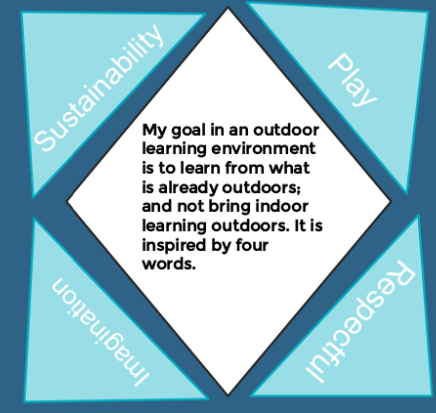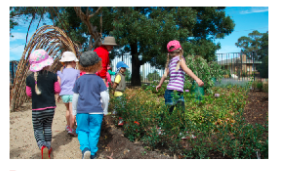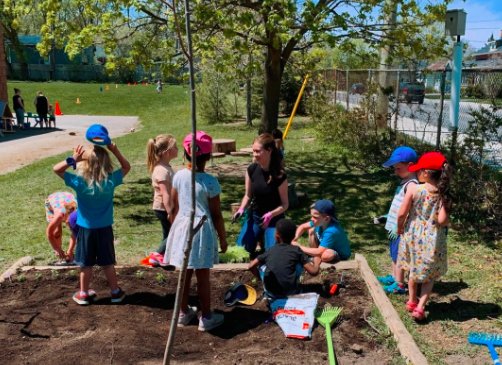To Challenge Dominant Discourses of How and Where Collaborative Learning Occurs
Challenging dominant discourses in education is important for fostering inclusivity, equity, and diverse perspectives in community environments. It allows for the exploration of alternative approaches that better suit the needs of all learners, breaking away from popular norms and mainstream concepts that may limit creativity and growth. Dominant discourses are stories that have a decisive influence on a particular subject, for example early childhood education, by insisting that they are the only way to think, talk and learn, that they are the only reality (Moss, 2019). By embracing diverse perspectives and experiences, we create richer learning environments that promote critical thinking, empathy, and a deeper understanding of the world around us. These artifacts explore the ways that educators can challenge where and how they teach and provoke community in early years environments from moving class outdoors, movement-based learning, and Indigenous teaching and learning.
Artifact 2: Sometimes I Feel Like A Fox
Artifact 2 is a slide show that could be used by educators as guide during a exploration about the Anishinaabe totem animals that was guided by Danielle Daniel’s book “Sometimes I Feel Like A Fox”. This experience was cross-curricular as it combined socio-emotional learning, literacy, art and Indigenous teaching. As mentioned in our course module, “Battiste (2000) posited that we need to find new and respectful ways to include both Indigenous knowledge and contemporary forms of meaning making in classrooms to bring about an educational context that respects and builds on both Indigenous and eurocentric knowledge systems,” (Singh, 2022).
Children were encouraged to connect with Indigenous teachings and reflect on their own experiences and emotions to guide their learning. This artifact encourages educators to provide students with an opportunity to move and learn in an un-traditional convention. They are encouraged to explore their surronds and reflect during movement.
Artifact 3: Outdoor Education
Artifact 3 is a proposal I made to describe how I would be implementing/designing an outdoor classroom during our Advanced Seminar on Research in Early Childhood Education course. I was inspired to change my kindergarten's traditional discourse and moved to a half-day outdoor Kindergarten program in Ontario. As I was navigating my first year of teaching, my indoor program was not working. After research and inspiration from colleagues and observing how my class thrived during outdoor learning, I decided to explore shifting to an outdoor classroom.
Our society holds specific ways of thinking, stories, or talking about things (Moss, 2019). Many of these effective methods become the common discourses, the more straightforward or comfortable way of doing things, and evidently the only reality. This change did prompt some anxiety and nervousness, but the observations and growth were beyond my expectations. The children's mindsets, behaviors, and curiosities changed. Similar to Reggio Emilia's perspectives, our outdoor program became a place to celebrate and honour "the child as a rich child, a child of infinite capabilities" (Dahlberg, Moss, & Pence, 2013, p. 129) By changing the environment, children continued to experience opportunities to connect with each other freely and naturally through play more than in a traditional indoor classroom setting. Each space is explored and intentionally created to encourage collaboration and connection.
Artifact 1: Community Class Gardening
Engaging in gardening with children epitomizes Vygotsky's theory of social development, highlighting the importance of shared experiences in learning and bonding. Working together in the garden fosters a sense of togetherness when collaborate on nurturing plants and cultivating a love for growing things. During our Leadership and Policy in Early Childhood Education course, I worked alongside my colleagues to learn about community gardening and collaborative leadership through the “Victory Garden“ program.
In 2022, my Kindergarten class and I created a class garden. We planned and designed the garden, dedicating time to nurturing its growth and eventually harvested our vegetables and flowers. Just as each plant in the garden relies on the support and care of the others, our class community flourished through collaboration and shared responsibility in cultivating our garden. An outdoor garden challenges the dominant discourse of a linear approach to learning that prioritizes individual growth. This hands-on project exemplifies how engaging in collaborative activities can deepen connections and foster a sense of belonging within the classroom community.
Indigenous pedagogies focus on the development of a human being as a whole person. Academic or cognitive knowledge is valued, but self-awareness, emotional growth, social growth, and spiritual development are also valued. Gardening provides a unique opportunity for development of the whole child while intertwining Indigenous ways of learning.




